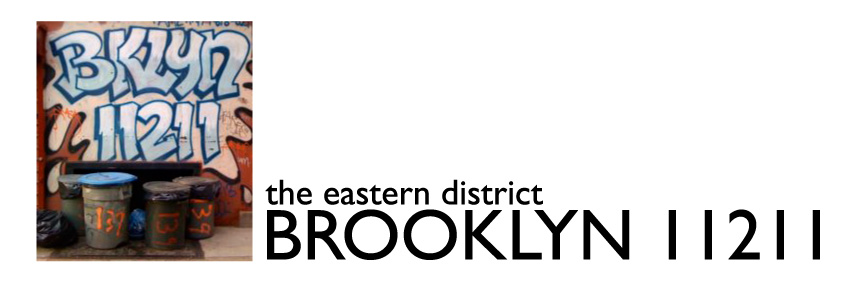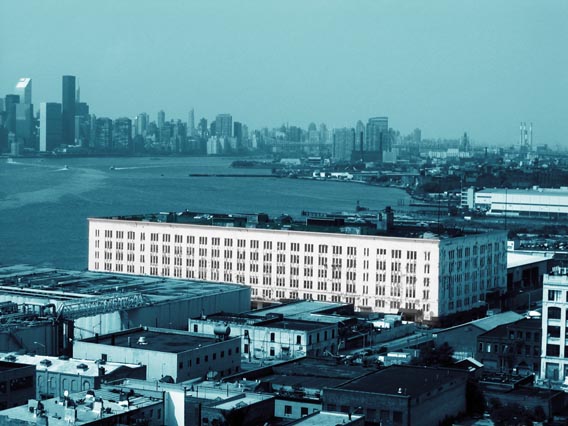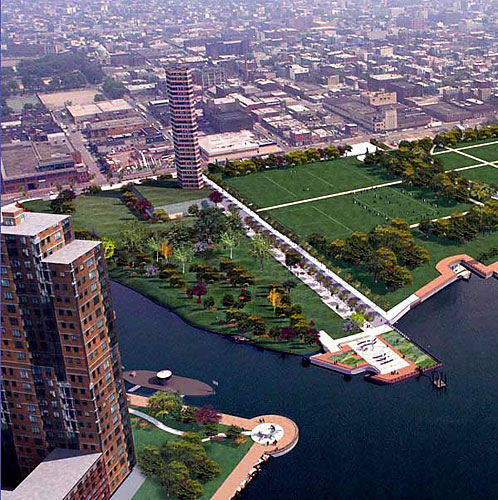The Domino rezoning hits CB1’s Land Use Committee tonight. As a result, I have spent the better part of the past few weeks reading and rereading the Environmental Impact Statement (EIS) (and thereby neglecting things like blogs and tweets), trying to get my head around the thing. And after all that, I think I can sum up the Domino rezoning in two words:
It’s big.
Supersize gigundo big, in fact.
The total project is over 2.8 million square feet of residential, retail, community facilities and office space concentrated on 6 blocks of Southside Williamsburg. Most of that, 2.4 million square feet, is for residential apartments. At about 1,000 square feet (gross) per unit (the developer’s estimate), that works out to 2,400 units. At 2.5 persons per unit (a conservative number), we’re looking at 6,000 new residents.
That’s a 24% increase in the population of the area west of the BQE that encompasses South Williamsburg (to just past Division Avenue), the Southside and the Northside (to North 10th Street).
(Community Preservation Corporation Resources (CPCR), the lead developer, is saying that they will “only” build 2,200 (a potential population increase of “only” 22%), but the zoning regulates floor area (square footage), not number of units or number of people. Market-rate development in the neighborhood has been heavily skewed toward one- and two-bedroom apartments, and if CPCR went that route, the number of units could easily exceed the 2,400 estimate in the EIS.)
The affordable housing is big too. CPCR proposes to make 660 of those units affordable at a variety of income levels. If they stick to their 2,200 total units, that works out to 30% of the total development. (The developer’s proposal is for 660 units, not a fixed percentage of the overall development.)
In terms of how this proposal compares to past rezonings, two words: much bigger. 33% bigger, to be precise. If the Domino project were developed according to the standards of the 2005 rezoning, it would be 600,000 square feet (550 units) smaller. (Worth remembering – CB1 voted against the 2005 rezoning because, among other things, it was too big and did not provide enough affordable housing – the community demanded 40% affordable and wound up with 33%.)
Put another way, the 2005 rezoning anticipated 5,544 new residential units on the Williamsburg and Greenpoint waterfront. The Domino rezoning would increase the potential number of waterfront housing units by 43%.
Retail and Office Space
The retail portion of the project is big too. 127,000 square feet big. That’s half again as much as the total new retail development projected for the entire 184-block 2005 Greenpoint/Williamsburg rezoning. On top of that, CPCR is proposing to construct two office towers at the north end of the site with just under 100,000 square feet of commercial office space within.
Open space
Domino does open space big too. The proposed development would result in just under 4 acres of publicly-accessible open space. The waterfront portion of the open space would be turned over the Department of Parks and Recreation for administration (with Domino paying for upkeep, same as Northside Piers and the Edge have done). In addition to the 1/4-mile long waterfront esplanade, there will also be four “upland connectors” (you and I would call them streets, extending the Southside street grid west of Kent Avenue), to which Parks would be granted an easement for permanent public use. The open space would also include a large lawn to the west of the refinery building (which, being a landmark, is retained in the development) and two playgrounds. Most of the open space is mandated by the waterfront zoning, though only three of the four upland connectors are required, so the addition of the fourth connector is a major plus in terms of the overall urban design.
But even with all this new open space, when all the new residents are accounted for, the community winds up with less open space per resident that we have now. About 6% less within the half-mile study area examined in the EIS (extending from Division Avenue to North 10th Street and as far east as Roebling Street). If you know this area, you know there is not much open space to begin with. In fact, this area has barely a quarter of the amount of open space mandated by City Planning.
In order to meet the City’s guidelines for open space at current population levels, we would need to add 61 acres of new open space to Northside, Southside and South Williamsburg (the half-mile area surrounding the Domino site). And that’s before you add the 2,400 new units Domino would bring to the neighborhood. In order to meet City guidelines with the Domino residents, we would need to add almost 86 acres of new open space.
At the end of the day, despite the considerable amount of open space being provided by Domino, the huge number of new units (and hence new residents) actually results in less open space per person.
And there’s one more thing.
Remember those office towers at the north end of the site? Well, they are going to leave Grand Ferry Park in shadow for the better part of the day. (“During the warmer months (April through October), all areas of the park would continue to get several hours of sun in the morning, and most areas of the park would get sun later in the afternoon as well. However, several hours of new midday shadow would be cast on the park. In December, under [current conditions], sunlight is already limited throughout the day, and the proposed project would remove all or most of the remaining sunlight for about two hours around midday. Portions of the park would continue to receive direct sunlight [emphasis added] throughout the day during the spring, summer, and fall.”)
Parking
If you guessed big, you’re catching on. 1,694 parking spaces big. The zoning only requires 1,042 parking spaces, and permits a maximum of 1,541 spaces, so the developer is applying for a special permit to allow it to exceed the maximum. Why CPCR needs 63% more parking spaces than zoning requires is not clear.
Domino also provides 456 bicycle parking spaces, and if you think that is a lot, you’re wrong. Under the City’s new bicycle parking regulations, Domino should be providing 1,241 units of bicycle parking (including one for every two housing units).
Transit
There’s no wrapping my head around this one.
The project will have an adverse impact on crowding at the crosswalk at North 7th and Bedford, but somehow all those folks crowding the crosswalk won’t have an adverse impact on the L train itself. (I guess because the L train is already pretty much at capacity, what’s another 700 riders during the morning rush?)
Domino would also have a “significant adverse impact” at the Marcy Avenue J/M/Z stop (where 40% of the riders from the project are expected to go to catch the train). One solution to the J/M/Z impacts is to not allow people to enter the train at the Havemeyer end of the platform. Instead, people (including Domino residents) should walk an extra block to the Marcy Avenue entrance. Somehow I don’t see that encouraging Domino residents to use the J/M/Z.
Actually, that and a shuttle bus are the only mitigation solutions to adding almost 2,500 additional subway trips to the morning and evening rush.
The truth is that when it comes to transit and transportation, there has been very little planning or mitigation for all the new development that already been approved (we’re still waiting for the MTA to widen the stairs at Bedford Avenue). It’s also true that there is really nothing that CPCR can do to mitigate any of its transit impacts, unless it proposes to build a new tunnel to Manhattan. So until that happens, its shuttle buses and “a multitude of alternative commuting options [that] may also be provided”.
Or, as the EIS puts it in a more candid moment, “absent such mitigation measures, the proposed project would result in an unmitigated significant adverse transit impact.” And we’ll just leave it at that.




